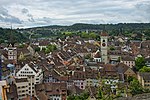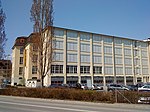Schaffhausen railway station

Schaffhausen railway station (German: Bahnhof Schaffhausen) is a railway station in Schaffhausen, the capital of the Swiss canton of Schaffhausen. The station is jointly owned by the Swiss Federal Railways (SBB CFF FFS) and Deutsche Bahn (DB), and is served by trains of both national operators, as well as trains of the Swiss regional operator Thurbo. The station is a major intermediate station on the DB's High Rhine Railway that briefly transits Swiss territory on its route along the northern bank of the High Rhine between Basel and Singen. The station is also linked to the rest of Switzerland by the Rheinfall line to Zürich via Winterthur, the Eglisau to Neuhausen line that crosses German territory (some trains call at Jestetten and Lottstetten in Germany) to reach Eglisau and Zürich, and the Lake line to Rorschach via Stein am Rhein.
Excerpt from the Wikipedia article Schaffhausen railway station (License: CC BY-SA 3.0, Authors, Images).Schaffhausen railway station
Löwengässchen,
Geographical coordinates (GPS) Address Nearby Places Show on map
Geographical coordinates (GPS)
| Latitude | Longitude |
|---|---|
| N 47.698281944444 ° | E 8.6327561111111 ° |
Address
Schaffhausen
Löwengässchen
8202 , Emmersberg
Schaffhausen, Switzerland
Open on Google Maps









